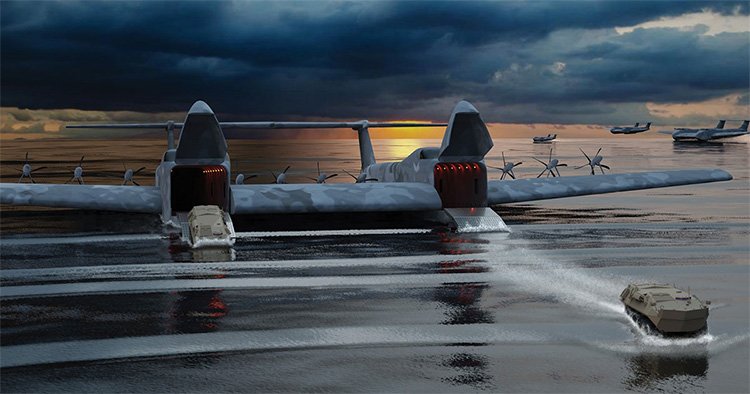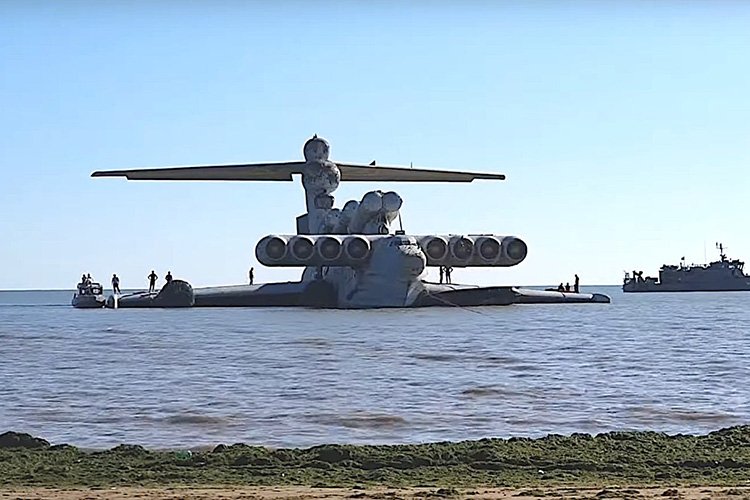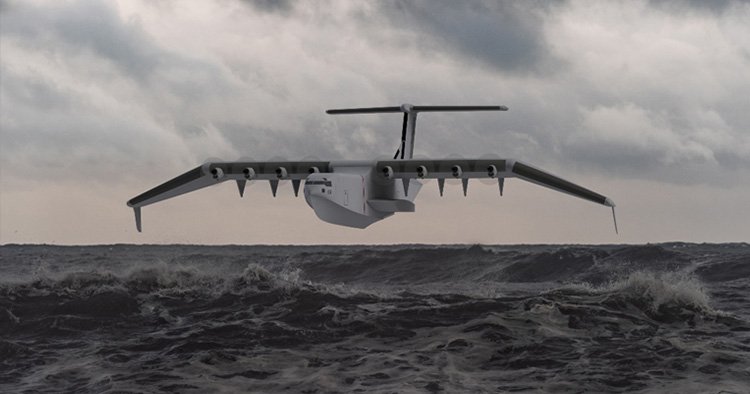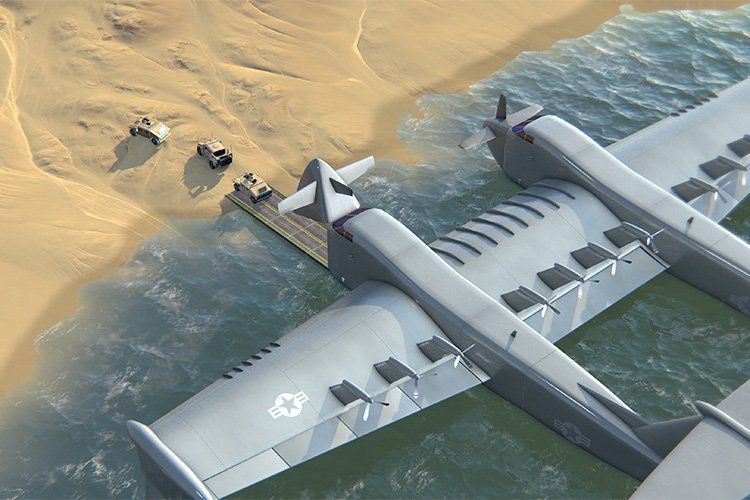The Defense Advanced Research Projects Agency, DARPA, is looking to revolutionize the future of amphibious warfare by exploring a century-old concept to create an entirely new class of flying boat.
Dubbed the “Liberty Lifter Program,” DARPA’s goal is to design a large, long-range experimental flying boat that can be used for seaborne strategic and tactical heavy lift operations.
According to solicitation documents, the Liberty Lifter will be able to fly at altitudes of at least 10,000 feet and have an operational range of up to 4,000 nautical miles. The aircraft will also be able to carry payloads over 90 tons, with nose and/or tail ramps to allow for the rapid sea-to-shore off-loading of cargo during amphibious assault or supply operations.
Most ambitiously, DARPA wants its Liberty Lifter to have ground-effect vehicle capability that would allow it to glide just above the water’s surface at speeds exceeding 250 knots (288 mph).
While DARPA has referred to the proposed Liberty Lifter X-plane as a “flying boat” based on its program goals, the Pentagon’s advanced research and development arm is apparently looking to harness several aeronautical concepts to develop an entirely new breakthrough class of amphibious aircraft.
And despite this daunting challenge, the Liberty Lifter program is moving forward, with DARPA recently announcing the selection of two major aerospace companies to design a full-scale hybrid flying boat demonstrator.


DARPA Looking Back To The Future For The Next Generation Flying Boat
The concept behind DARP’s Liberty Lifter involves two distinct types of amphibious aircraft, the seaplane, and the flying boat, first developed and widely used over 100 years ago in the early 20th century.
“Seaplane” or “floatplane” refers to aircraft with floats or pontoons mounted under the fuselage, allowing the aircraft to land or take off on the water. Many modern seaplanes are outfitted with floats and retractable wheeled landing gear, allowing the aircraft to land on water or a traditional runway.
“Flying boats” likewise land on water. However, instead of landing on mounted floats, these types of aircraft use a purpose-built hydrodynamically shaped fuselage to allow water to flow around it and maintain buoyancy like a ship’s hull. Unlike seaplanes, flying boats typically lack wheel or skid configurations, limiting the aircraft to only being able to land on water.
The most extensive use of amphibious planes was during the early days of aviation and around World War I. The limited range of early aircraft and the general lack of airfields made the ability to land and take off on water extremely advantageous.
During World War II, every coastal nation operated seaplanes and flying boats, mainly for anti-submarine patrols and airborne reconnaissance of enemy naval ships.
After World War II, the use of amphibious airplanes rapidly declined due to the considerable increase in land-based runways and the extended range of modern aircraft.
Today, single-engined, light-sport class seaplanes like the Cessna 208B Caravan Amphibian or DHC-3 Otter are typically used for reaching remote water-based locations or long-range air-sea rescue.
Flying boats have become less common in the modern era. However, some planes, like the Consolidated PBY Catalina or Canadair CL-415, have found niche roles in aerial firefighting. These aircraft are modified to take in water while landing, which can be later dropped like a “water bomb” to combat wildfires.


Flying Boat or “Sea Monster?”
With the Liberty Lifter, DARPA wants an aircraft that has the maneuverability of a seaplane with the cargo capacity and shoreline access of a flying boat.
However, adding another wrinkle to the mix, solicitation documents clarify that DARPA also wants the Liberty Lifter to be a ground-effect vehicle.
In aerodynamics, “ground-effect” refers to a phenomenon in which a fixed-wing aircraft, while in motion, can “float” just above a surface before reaching adequate climb speed for flight.
Ground-effect occurs because as an aircraft moves forward, the wings deflect incoming air mass downward toward the ground, forcing air pressure back onto the lower surface of the wings, generating a slight lift.
Ground-effect can be experienced as the brief sensation during takeoff when it’s apparent that the plane’s wheels are no longer touching the ground, yet the plane is still traveling down the runway and has not yet begun to climb in altitude.
Going back to the 1960s, the Soviet Union used ground-effect principles to develop its own hybrid boat-aircraft. Officially dubbed the “Korabl Maket” or “KM” (in English: “Model Ship”), the bizarre flying boat has become better known by its colloquial name: the “Caspian Sea Monster.”
Taking its maiden flight in 1966, the Caspian Sea Monster was a colossal piece of machinery. With a wingspan of 123 feet and measuring 302 feet in total length, the Caspian Sea Monster is the second largest aircraft ever built, just behind the Soviet-era Antonov An-225 Mriya.
As a ground-effect vehicle, the Caspian Sea Monster was designed to fly at an altitude of 16-33 feet, primarily over calm bodies of water like the Caspian Sea. While technically an aircraft, the massive flying boat was intended to be used like a naval vessel.
Despite its massive size, the KM flew below the minimum altitude of detection of most radar systems, making it virtually undetectable to aircraft early warning systems.
Additionally, the KM didn’t have to deal with the extreme drag of moving through the water, which meant it could move considerably faster than any surface vessel.
During testing, the Caspian Sea Monster reportedly achieved a maximum speed of 400-460 mph (350-400 knots). At these speeds, the KM could outrun the world’s fastest ship, the Spirit of Australia, by over 100 mph and would have been orders of magnitude faster than the maximum cruising speed of naval destroyers, roughly 30 knots (35 mph).
The Soviets envisioned the KM as a massive anti-shipping missile platform that could be used in the event of war with NATO.
The KM was tested in the Caspian Sea for 15 years until 1980 when it was destroyed in a crash. The stricken KM has since remained at the bottom of the Caspian Sea.
While a second KM was never built, the platform became the basis for the Soviet Lun-class ekranoplan, the only ground-effect vehicle ever operationally deployed as a warship.
A single Lun-Class ekranoplan, the MD-160, entered service with the Soviet Navy in 1987, outfitted six missile launchers mounted on the dorsal surface of its fuselage that could launch P-270 Moskit (Mosquito) guided missiles.
Following the 1991 collapse of the Soviet Union, the MD-160 sat abandoned at the Caspian Sea Naval Base in Kaspiysk for nearly three decades until 2020, when the aircraft was towed to a beach in Dagestan, southern Russia. The MD-160 has since become a museum and tourist attraction.
Since the demise of the Caspian Sea Monster and MD-160, several private aerospace companies have explored ground-effect vehicles as a possible means for faster and more efficient sea travel.
One of the primary challenges with developing a viable amphibious ground-effect vehicle is its susceptibility to rough sea conditions. Successive lines of waves while flying over the open ocean can cause stress on the aircraft and make it difficult to control.
DARPA also notes, “high-speed operation in ground effect increases the likelihood of [a] collision in congested environments with limited options for safe maneuvers.”


Despite the Challenges, DARPA’s Liberty Lifter Program is Moving Forward
DARPA is known for coming up with wild, high-risk, high-reward ideas, of which few ever come to fruition. However, at least for now, the agency is moving forward with its plans to develop a new class of ground-effect flying boats.
Last month, DARPA announced that two major aerospace companies -General Atomics, working with Maritime Applied Physics Corporation, and Aurora Flight Sciences, working with Gibbs & Cox and ReconCraft – had been selected to develop designs for a full-scale Liberty Lifter demonstrator.
“We are excited to kick off this program and looking forward to working closely with both performer teams as they mature their point-of-departure design concepts through Phase 1,” said DARPA Liberty Lifter Program Manager Christopher Kent. “The two teams have taken distinctly different design approaches that will enable us to explore a relatively large design space during Phase 1.”
Concept art reveals that the General Atomics team will attempt to advance a twin-hull, mid-wing design employing a distributed propulsion system using twelve turboshaft engines.
Aurora Flight will use a more traditional flying boat design, with a single hull, high wing, and eight turboprops for primary propulsion. Concept art shows the Aurora Flight aircraft using a pronounced gull-wing design, likely to increase lateral stability during dives and affect the aircraft’s climb rate for ground-effect performance.
DARPA expects the conceptual design work to take about six months, followed by nine months of preliminary design review. The total cost for this initial developmental phase is expected to be roughly $55 million.
Based on the current program timeline, DARPA hopes to select one of the two designs for fabrication and assembly by the first quarter of 2026. Initial flight testing is slated to begin at the end of 2027.
Finally, if all goes according to plan, DARPA believes it will be able to transition the Liberty Lifter flying boat to operational military service by 2028.
Tim McMillan is a retired law enforcement executive, investigative reporter and co-founder of The Debrief. His writing typically focuses on defense, national security, the Intelligence Community and topics related to psychology. You can follow Tim on Twitter: @LtTimMcMillan. Tim can be reached by email: tim@thedebrief.org or through encrypted email: LtTimMcMillan@protonmail.com

